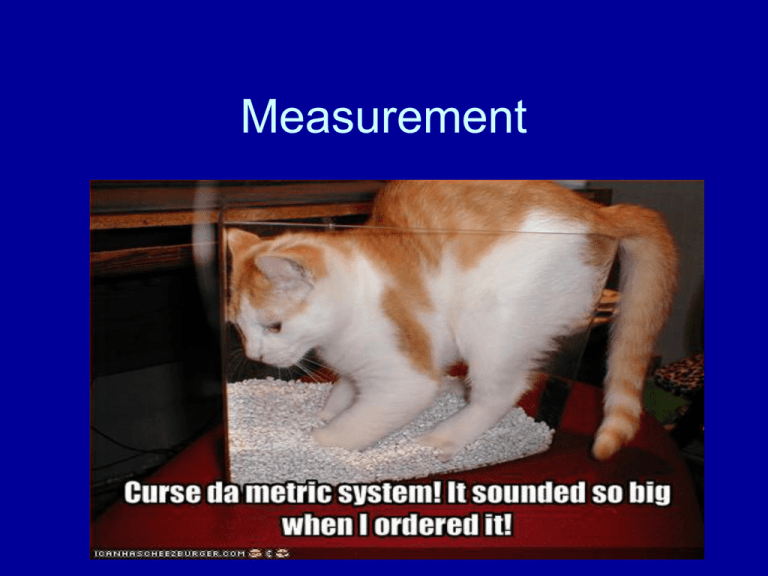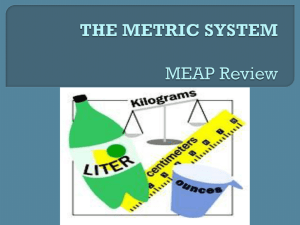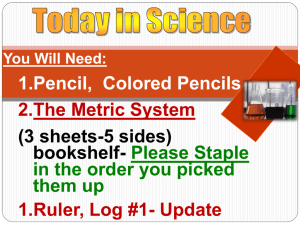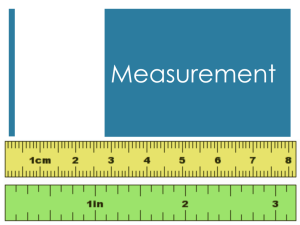Measurement
advertisement

Measurement Measurement Metric units • The fundamental units : • length is the meter (m) • Mass is the gram (g) • Volume is the liter (l) • Temperature is degree Kelvin (°K) – but Celsius (°C) is more commonly used Measurement Metric units • The metric system is based on the number 10 and therefore a decimal system • Prefixes precede the root or main word (gram, liter, meter). • The following prefixes are commonly used in science: Measurement Metric units • Examples: • A millimeter is about how thick as a toenail. • A centimeter is about as thick as a dime. • A kilometer is a little more than half of a mile. Measurement Conversions • The base represents gram, liter and meter. ------------------●-------●-------●------●--------●--------●--------------●-----------●---------●-----------●-------●--------●-------●------------*--Prefix: Mega Kilo Hecto Deca Basic Unit Deci Centi Milli Micro Abbrev: M k h dc m, l, g d c m mc or μ Measurement Conversions • Moving to the RIGHT ------increase • Moving to the LEFT -------decrease Measurement Conversions • Hint – we are referring to the exponent associated with 10 when we “count” places to move the decimal • We are NOT counting actual words listed on the chart For example • if you have 80 hl and you want to convert to cl then you must move 4 spaces to the right. • So you move your decimal point 4 spaces to the right. • Your answer is 800000 cl For example • if you have 5mg and you want to convert to g then you must move 3 spaces to the left. • So you move your decimal point 3 spaces to the left. • Your answer is 0.005g Measurement Length • The basic metric unit of length is the meter (m). • DIFFERENCES BETWEEN: – English units – Metric units Measurement Length Volume • When a figure has three dimensions (length, width, and height) we can find its volume. • In the metric system volume can be expressed in terms of liters or cubic centimeters (cm3 or cc) Volume • The meniscus is the curved interface between the water and air. • This is due to the surface tension and adhesive forces of water as it interacts with its container. A: The bottom of a concave meniscus. B: The top of a convex meniscus. Volume • In a laboratory you would work with • pipettes: pipette pump or filling device is used to draw and dispense fluids Volume • • • • In a laboratory you would work with Graduated cylinders Erlenmeyer flasks Beakers Mass • Mass is a measurement of the amount of matter in an object. It is determined by the molecular structure of the object. • Not to be confused with………….. Mass • Weight is a measure of the gravitational pull on an object. It is not the same as mass. Mass • In a laboratory you would work with Triple beam balance / Electronic scale Scientific Notation • Scientific notation uses powers of 10 so very large or small numbers can be expressed concisely. Scientific Notation • The number we use as the base for this system is 10. The exponent is the power of the number and is applied to the base. For example • Write the following large number using Scientific Notation : 146,000,000,000. – Step 1 :place the decimal after the first digit and drop all the zeros. 1.46 000,000,000_ - Step 2: count the number of places from the decimal to the end of the number. There are 11 places after the decimal point; therefore the exponent is 11. 1.46 X 1011 For example 0.00000123 – Step 1: with small numbers you count from the decimal the number of zeroes until you reach the first non-zero number 0.00000123 = 1.23 X10-6 Graphing Data Line graphs have both X axis and Y axis. Each X and Y axis is subdivided into uniform intervals.


